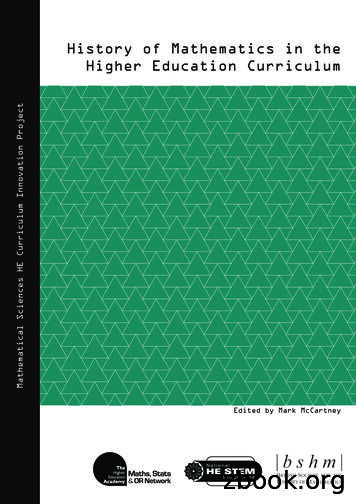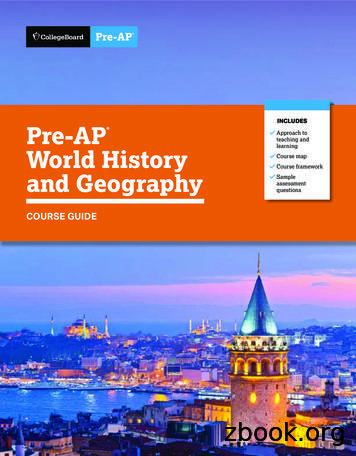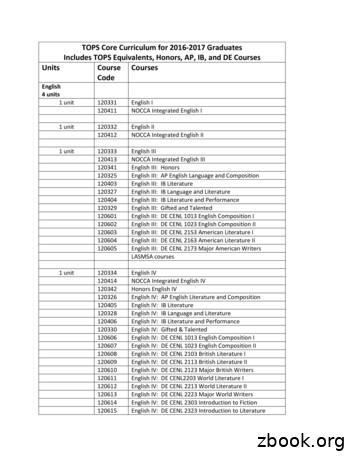Teaching World History
Teaching World HistoryH591 Section 26260Meeting place:Meeting time:Instructor:Office Hours:Office:Phone:Email:Ballantine Hall 221Mondays 4:00-6:00Leah ShopkowMondays and Wednesdays, 1:00-2:15 or by appointmentBallantine Hall 718855-1938 (office)ShopkowL@indiana.eduCourse ContentIf you get a job teaching college history (and we certainly intend for you to do so!) you will beexpected to teach at least one part of a world history or western civilization survey, unless you are anAmerican historian (and perhaps even if you are). Indiana University at Bloomington is highlyunusual in that we don’t teach broad western civilization or world civilization surveys--the othercampuses do and so do nearly all American colleges and universities. So how can you prepare toteach something you took long ago, if at all, and never had the opportunity to observe or assist inhere? The overarching goal of this course is to prepare you to teach your own courses in worldhistory. Therefore, we will1) Explore the notion of “World History,” to see how it is currently taught and defined byothers, and come to an understanding of how you might teach and define it;2) Examine the materials that are out there for teaching courses of this kind (books, readers,texts);3) Discuss general issues of course and syllabus design;4) Design two course syllabi, one for half of a world civilization survey, complete with a1
2selection of readings; and one for a topical world history course, complete with readings andactivities, that you might submit to the department as a proposal for a summer course. NB:We will design these courses with an eight-week session in mind.The exercises we will engage in during the semester will be intimately related to the above goals andreflected in the design of the course. A disclaimer: abandon all belief in “coverage” when you cometo class. We can’t do it all and won’t do it all! While pedagogical issues will be raised in this class, thiscourse will not substitute for "Teaching College History," where the pedagogical issues will be dealtwith in greater depth.Projects and AssignmentsThere are three major assigments in this class:1. A class report on a World History textbook. You will read and assess a World Historytextbook. There are a number of World History textbooks (not the most recent, I’m afraid)in the pedagogy library). Copies of your assessment are to be available for the rest of thestudents in the class. We will post these assignments on a portion of the web site only opento members of the class. This assignment is due2. A World History Survey Syllabus. You will design a syllabus for a survey class in worldhistory appropriate for college freshmen and sophomores, complete with readings and someassignments. This syllabus will be evaluated for its coherence, appropriateness, and howinteresting a course it seems to be. It will be evaluated by the whole class (each person willpresent his or her own syllabus). I urge you to swap information with each other, particularlywith respect to readings you might include. You should choose the period that you are mostlikely to teach (for pre-modernists, the period to 1500; for modernists, 1500 to the present).There are several reasons for this. This syllabus will be due3. A complete syllabus with assignments and exams for a topical course in World History thatyou would like to teach (for example, “Cities in World History,” “Women in WorldHistory,” “Epidemics,” or the like). You will design this as an eight-week course, becauseyou will then be able to submit the course to the History Department to teach in thesummer. You will be asked to submit a statement of teaching philosophy with this syllabus.The final version of this material will be due on the Monday of finals week, but you willpresent your course to the class during the last class.BooksRoss Dunn, The New World History: A Teacher’s CompanionPatrick Manning, Navigating World History: Historians Create a Global PastPhilip Pomper, Richard H. Elphick, and Richard T. Vann, eds. World History: Ideologies, Structures, andIdentitiesGrant P. Wiggins and Jay McTighe, Understanding by Design, 2nd ed.These books take you in three directions. The Wiggins and McTighe is not particularly aimed atcollege teachers, but is of more general application. You’ll never wonder why your students freeassociate in totally irrelevant ways again after you read about some of the silliness they encounteredin the teaching of K-12 students. More important, it suggests a really useful way to think aboutcourse design. Pomper et al. and Manning are really more aimed at those who want to makeWorld History a research field than those who are to teach it (although you’ll notice some overlap
3between the Pomper’s collection and Dunn’s). Dunn’s book is more clearly aimed at those who’vebeen thrown off into the deep end of the pool, although he himself is committed to World History.Course CalendarDateTopic and ReadingAssignmentsdue and questions to think aboutAug. 28Thinking about Teaching World HistoryReading:William H. McNeill, "The Changing Shapeof World History," History and Theory34/2 (1995): 8-26; also in World History:Ideologies, Structures, and Identities, ed.Philip Pomper, Richard H. Elphick, andRichard T. Vann (Oxford: Blackwell,1998)David Pace, “The Amateur in the OperatingRoom” American Historical Review 104(2004): 1171-92.What are the goals of H591?What do you want to get out ofit? What kinds of topics andapproaches would make a worldhistory course truly useful?Sept. 4Course and Learning GoalsWhat goals should your courses have? Why arethese appropriate goals for your course?Fill out two copies of theTeaching Goals inventory, onefor a general survey class, one fora topical world history course.What would your inventoriessuggest about how to organizedthese courses?ReadingUnderstanding by Design (whole thing).Classroom Assessment Techniques:"Teaching Goals Inventory"Learning by Design is not aimed primarily at thoseteaching college, but it raises general issues ofcourse design and learning. Classroom AssessmentTechniques is available in the pedagogy library(Alexia's office).
4Sept. 11PacingTeaching Within the Rhythms of the Semester, part 2Teaching College Freshmen, part 1The Beloit college mindset list http://www.beloit.edu/ pubaff/mindset/ I didn’t have you buy either of these books. Thesecond is quite a useful introduction to ourstudents, but I don’t think you’ll particularlywant to own either for the long haul. There arecopies of both in the Pedagogy Library. Thetone in Rhythms is relentlessly chipper, whichcan really grate on one’s nerves, but the topic isan important one to think about. The mindsetlist speaks for itself (although we’ll talk aboutit).Sept. 18Problematizing (ugh) the teaching ofHistoryWhat does it mean to think historically?Wineburg, Historical Thinking and Other UnnaturalActs, 3-136 (five essays).What does it mean to thinkhistorically?What are the implications ofWineburg’s studies for ourteaching?A copy of Wineburg's book is available in thepedagogy library. Copies of the individual essaysare in the course binder in the pedagogy library.Sept. 25The Rise of World HistoryNavigating World History, part 1The New World History, part 1What is (are) the implicitprogram(s) behind the teaching ofWorld History? How does itaffect what gets taught?Oct. 2Know the Enemy: TextbooksRead a world history textbook of your choice(for the period you will be writing a syllabus)and assess it.Written assessment of thetextbook of your choice.Oct. 9History on a Global ScaleReadingNavigating World History, part 4The New World History, parts 5 & 7What do we mean by “worldhistory” in the phrase “teachingworld history”?
5Oct. 16ActivitiesReadingJust-In-Time-Teaching: Blending Active Learningwith Web Technology, pp. 1-66Classroom Assessment Techniques, part 1James F. Voss and Jennifer Wiley, “A CaseStudy of Developing HistoricalUnderstanding via Instruction: TheImportance of Integrating TextComponents and Constructing Arguments”and “The Sourcer’s Apprentice: A tool forDocument-Supported History Instruction,”M. Anne Britt, Charles A. Perfetti, Julie A.Van Dyke, and Gareth Gabrys in Knowing,Teaching & Learning History, Peter N. Stearns,Peter Seixas, and Sam Wineburg (NewYork: NYU, 2000).what kinds of assignments areyou going to give your studentsand to what ends?All these materials are in the pedagogy library.Oct. 23Who’s In, Who’s Out?ReadingWorld History, articles by Adas, Nandy,Eisenstadt, WurgaftThe New World History, part 6Oct. 30First SyllabiNo reading for this week; you probably haveenough to do, already. Remember that thesyllabus should contain all readings (these mightbe from a reader or selections that you havemade).What does one gain by takingcertain approaches to WorldHistory? What does one give up?First syllabus due (survey course,big-bang to 1500 or 1400 topresent)Class presentations of syllabiNov. 6Developments in Historical InquiryReadingNavigating World History, parts 2 & 3Nov. 13Comparative History/Gender HistoryReadingThe New World History, parts 8 & 9How have changes in the fields ofinquiry in the discipline affectedWorld History?Are these alternative approachesto World History, or should theybe an integral part of it? Andhow?
6Nov. 20I think that we will not meet this week,provided that there is no objection. Or it couldbe next week instead.Nov. 27Last ThoughtsReadingThe New World History, part 11World History, part 4Where is the teaching of WorldHistory going? Can we makeworld history courses a moremeaningful experience forstudents?Dec. 4Topical World History CoursesClass presentation and discussion of topicalhistory course syllabi.Draft version of World Historysyllabus dueDec. 11Final version of Topical World History syllabus due by 5:00.
Read a world history textbook of your choice (for the period you will be writing a syllabus) and assess it. Written assessment of the textbook of your choice. Oct. 9 History on a Global Scale Reading Navigating World History, part 4 The New World History, parts 5 & 7 What do we mean by “world history”
What is a Teaching Portfolio? A Teaching Portfolio Outline What makes it Reflective? Moving forward What are the parts of a Teaching Portfolio Teaching Responsibilities Teaching Philosophy Teaching Methodologies Course Materials & Student Learning Teaching Effectiveness Teaching Improvement Activities
History and is currently editing an Encyclopedia of Modern World History. He has written several thematic studies in world history, including The Industrial Revolution in World History (2nd ed., Westview, 1998), Gender in World History (2nd ed., Routledge, 2006), Consumerism in World History (2nd ed.,
Contents Introduction 5 Teaching the history of mathematics at the University of St Andrews 9 History in the undergraduate mathematics curriculum – a case study from Greenwich 13 Teaching History of Mathematics at King’s College London 15 History for learning Analysis 19 History of Mathematics in a College of Education Context 23 Teaching the history
ABOUT PRE-AP WORLD HISTORY AND GEOGRAPHY 11 Introduction to Pre-AP World History and Geography 11 Pre-AP World History and Geography Areas of Focus 15 Pre-AP World History and Geography and Career Readiness 16 Summary of Resources and Supports 17 Pre-AP World History and Geography: Two Pathways 18 Course Map: Pathway 1 20 Course Map: Pathway 2
Unit 6: World History Semester 1 Review and Exam Lesson 6.1: World History Semester 1 Review and Exam 6.1.1: Review - World History Semester 1 Duration: 1 hr 6.1.2: Exam - World History Semester 1 Duration: 30 min _ / 100 6.1.3: Final Exam - World History Semester 1 Duration: 1 hr _ / 100 Unit 7: An Age of Exploration and Colonization
Modern teaching methods and strategies Part I . Language teaching methodology, or teaching in this sense, is a set of methods based on the same rules and having a common aim, e.g. to encourage students to use the language, involve the studentsFile Size: 732KBPage Count: 55Explore further150 Teaching Methodsteaching.uncc.eduTEACHING TECHNIQUES - Oneontaemployees.oneonta.edu/thomasrl/Y (PDF) 50 METHODS OF TEACHING.pdf GRACE SIKALEYA .www.academia.eduChapter 4 Current approaches and teaching methods .www4.ujaen.es/ gluque/Chapter4H Teaching Methods and Strategies: The Complete Guidewww.educationcorner.comRecommended to you b
220405 US History: IB History of the Americas I 220406 US History: Gifted and Talented 220409 US History: Honors 220614 NOCCA Integrated World History IV 220407 US History: DE CHIS 2013 American History I 220408 US History: DE CHIS 2023 American History II LASMSA courses 1 unit 220501 Civics 1 year 220502 Government
Unit 14: Advanced Management Accounting Unit code Y/508/0537 Unit level 5 Credit value 15 Introduction The overall aim of this unit is to develop students’ understanding of management accounting. The focus of this unit is on critiquing management accounting techniques and using management accounting to evaluate company performance. Students will explore how the decisions taken through the .























